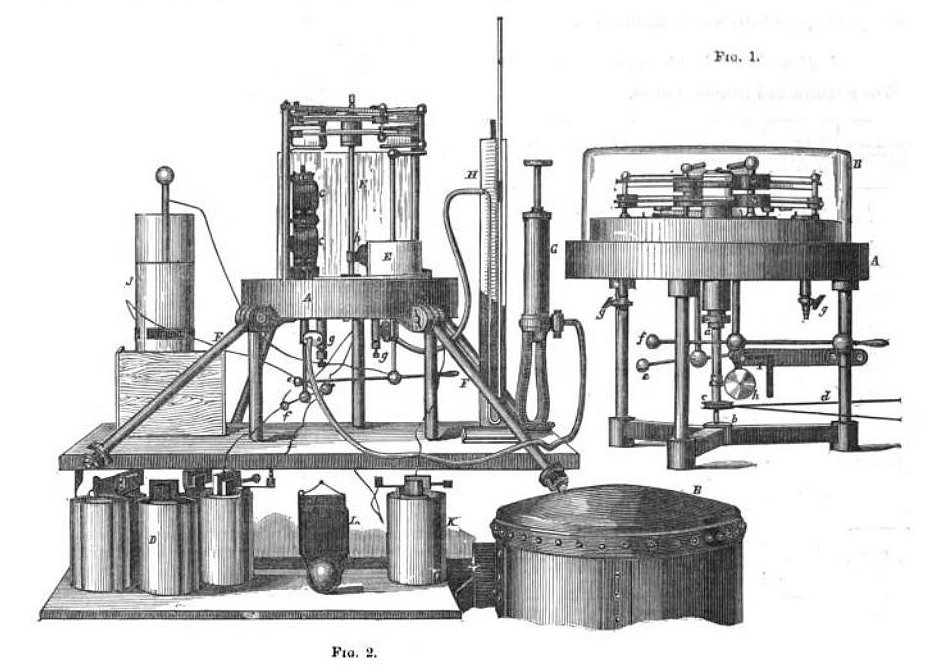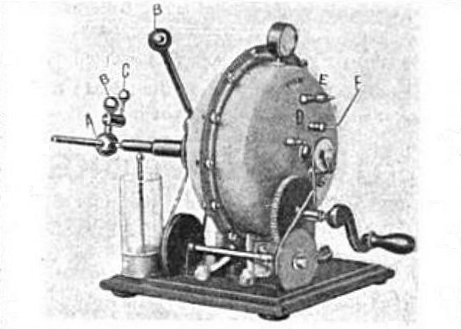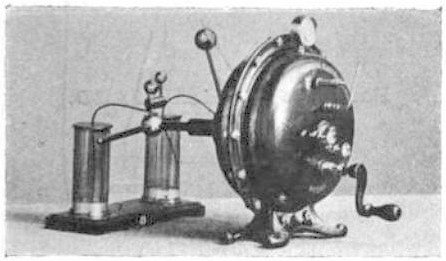Pneumatic electrostatic
machines
By 1885, Walter Hempel [1][2]
found that by enclosing an electrostatic machine in a pressurized
vessel it was possible to increase its output current significantly,
due to the increased breakdown voltage of pressurized gases. The
machine used was of the Toepler type (not clear what structure),
mounted under a glass cover for experiments at normal pressure (Fig.
1) and in an iron box for experiments at high pressure (Fig. 2). The
machine was tried at several pressures and with different gases, and
it was found that by increasing the pressure it was possible to
obtain a consistent increase in the output current with the
pressure. Experiments were reported with air, hydrogen, and carbon
dioxide. The measurement method was to count the number of
discharges of a Leyden jar for 400 turns of the machine. Presures up
to 7 atm were used for air, with measured current increase of 2.7
times at 4 atm. The results with carbon dioxide were the best, with
an increase of 5.9 times at 3 atm. It was also found that with less
than 0.5 atm the machine would not work.
A Wimshurst machine enclosed in a pressure vessel was patented by
Frederick Tudsbury [3][4] in 1900. He was an instrument maker, and
built several models of the machine in the early 1900's. Advertisings showing these machines
appear in publications from 1906.
A large machine with 60 disks was built by O. Leuner and O. Lehman
[5][6], for the Institute of Physics in Karlsruhe, Germany.
Electrostatic machines operating in compressed gases continued to be
developed in the XX century, with Van de
Graaff generators and similar machines, some of great
dimensions (1,2)
, and the several rotating machines developed by N. Felici. More
about these developments can be found in the site of Lyonel
Baum.
Electrostatic machines operating in high vacuum are also possible. This thesis from J. G. Trump (MIT 1933) describes some of the first experiments.
References:
[1] W. Hempel, "Die Hochdruck-Influenz-Electrisirmaschine," Annalen
der Physik, 261, 7, pp. 487-493, 1885.
[2] W. Hempel, "A high-pressure influence electric machine", The
telegraphic journal and electrical review, August 1, 1885, pp.
90-92.
[3] F. Tudsbury, "Improved means for increasing the efficiency of
high tension electric influence machines," Patent #22731, 1900.
[4] J. A. Bergonié and G. H. Bécou, "Archives
d´électricité médicale," Vol. 14, p. 56,
1906.
[5] J. Frick and O. Lehmann, "Dr. J. Fricks physikalische Technik,
oder, Anleitung zu Experimentalvorträgen sowie zur
selbstherstellung einfacher Demonstrationsapparate," Volume 2, F.
Vieweg und Sohn, 1907.
[6] O. Lehman, "Beobachtungen über electrische Entladungen bei
einer grossen Influenzmaschine," Annalen der Physik, 280, 12. pp.
642-653, 1891.
Created: 28/8/2011
Last update: 4/10/2012
By Antonio Carlos M. de Queiroz
Return to Electrostatic Machines.




